Corporate Finance Discussions: Capital Structure & Payout Policies
VerifiedAdded on 2023/04/25
|7
|1378
|494
Discussion Board Post
AI Summary
This document presents a student's discussion on corporate finance topics, focusing on capital structure and payout policies. The capital structure discussions cover the importance of an optimal capital structure for firm value, efficient fund utilization, and balancing debt and equity. It also touches upon the role of market sources and the consideration of various financial instruments in constructing a capital structure. The payout policy discussions delve into dividend distribution, the impact of debt reduction and share repurchase, and the influence of cash reserves. Different payout policies, including residual, stability, and hybrid policies, are examined for their effects on shareholder value and financial decision-making. This resource provides insights into the theoretical and practical aspects of corporate finance, useful for students studying finance and related fields. Desklib offers a range of study tools and solved assignments to support student learning.
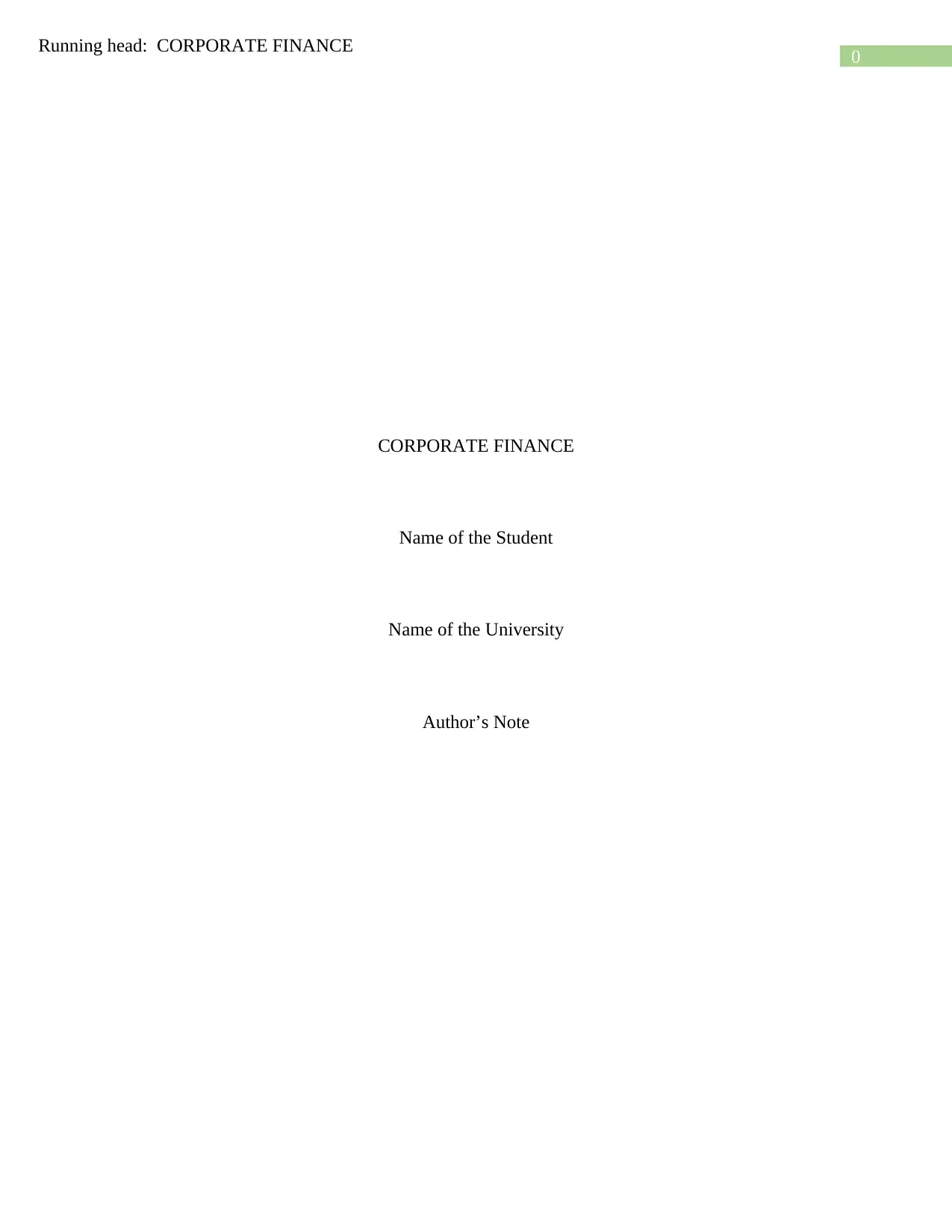
0
Running head: CORPORATE FINANCE
CORPORATE FINANCE
Name of the Student
Name of the University
Author’s Note
Running head: CORPORATE FINANCE
CORPORATE FINANCE
Name of the Student
Name of the University
Author’s Note
Paraphrase This Document
Need a fresh take? Get an instant paraphrase of this document with our AI Paraphraser
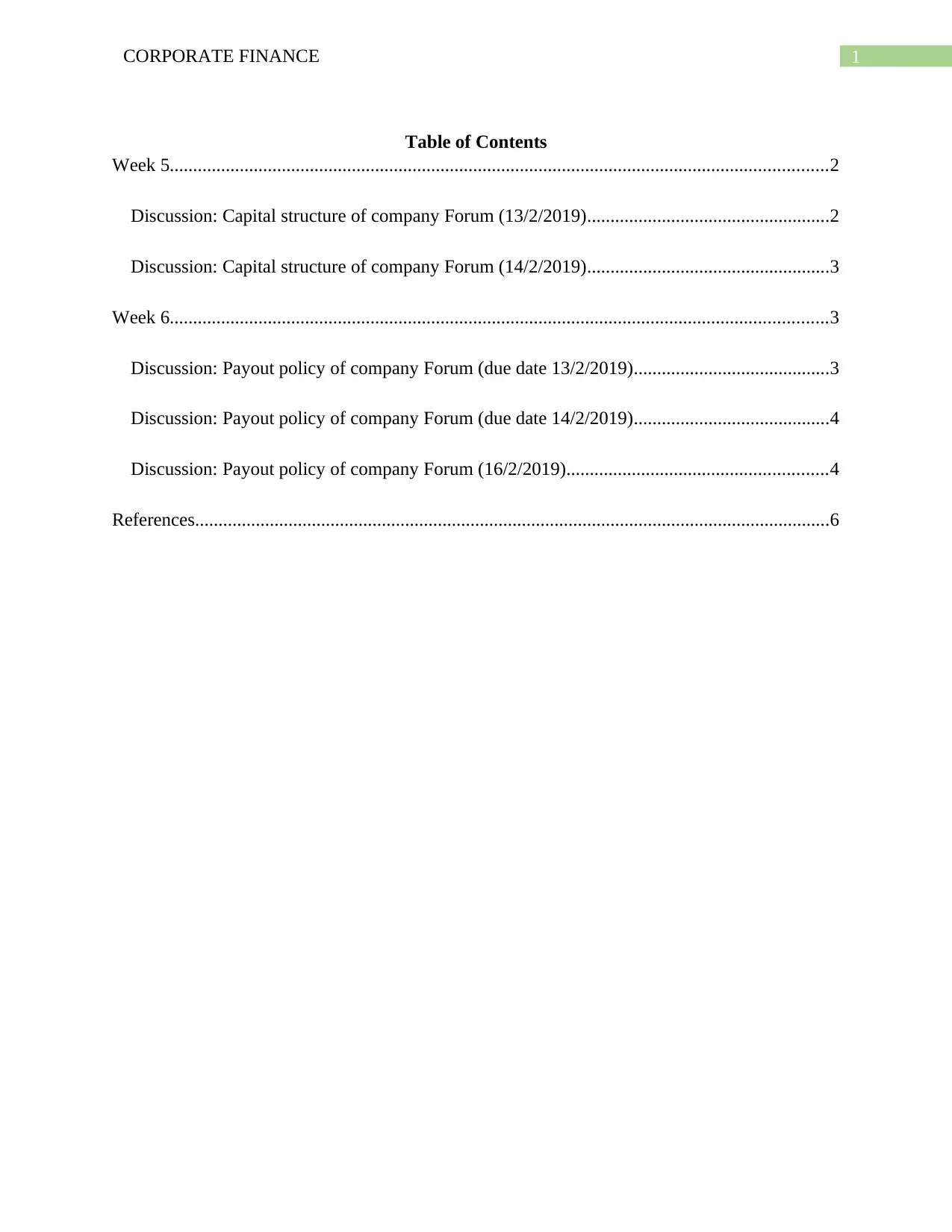
1CORPORATE FINANCE
Table of Contents
Week 5.............................................................................................................................................2
Discussion: Capital structure of company Forum (13/2/2019)....................................................2
Discussion: Capital structure of company Forum (14/2/2019)....................................................3
Week 6.............................................................................................................................................3
Discussion: Payout policy of company Forum (due date 13/2/2019)..........................................3
Discussion: Payout policy of company Forum (due date 14/2/2019)..........................................4
Discussion: Payout policy of company Forum (16/2/2019)........................................................4
References........................................................................................................................................6
Table of Contents
Week 5.............................................................................................................................................2
Discussion: Capital structure of company Forum (13/2/2019)....................................................2
Discussion: Capital structure of company Forum (14/2/2019)....................................................3
Week 6.............................................................................................................................................3
Discussion: Payout policy of company Forum (due date 13/2/2019)..........................................3
Discussion: Payout policy of company Forum (due date 14/2/2019)..........................................4
Discussion: Payout policy of company Forum (16/2/2019)........................................................4
References........................................................................................................................................6
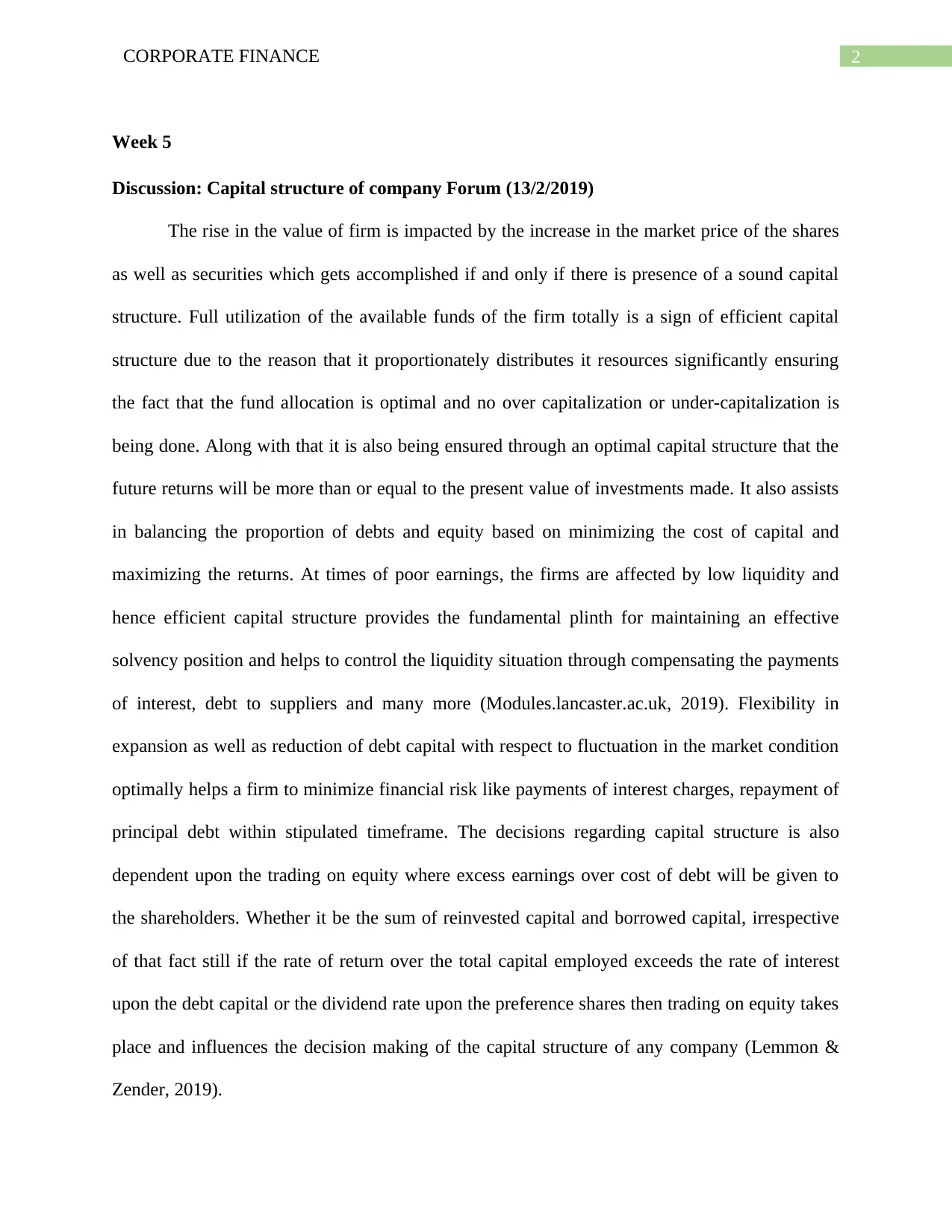
2CORPORATE FINANCE
Week 5
Discussion: Capital structure of company Forum (13/2/2019)
The rise in the value of firm is impacted by the increase in the market price of the shares
as well as securities which gets accomplished if and only if there is presence of a sound capital
structure. Full utilization of the available funds of the firm totally is a sign of efficient capital
structure due to the reason that it proportionately distributes it resources significantly ensuring
the fact that the fund allocation is optimal and no over capitalization or under-capitalization is
being done. Along with that it is also being ensured through an optimal capital structure that the
future returns will be more than or equal to the present value of investments made. It also assists
in balancing the proportion of debts and equity based on minimizing the cost of capital and
maximizing the returns. At times of poor earnings, the firms are affected by low liquidity and
hence efficient capital structure provides the fundamental plinth for maintaining an effective
solvency position and helps to control the liquidity situation through compensating the payments
of interest, debt to suppliers and many more (Modules.lancaster.ac.uk, 2019). Flexibility in
expansion as well as reduction of debt capital with respect to fluctuation in the market condition
optimally helps a firm to minimize financial risk like payments of interest charges, repayment of
principal debt within stipulated timeframe. The decisions regarding capital structure is also
dependent upon the trading on equity where excess earnings over cost of debt will be given to
the shareholders. Whether it be the sum of reinvested capital and borrowed capital, irrespective
of that fact still if the rate of return over the total capital employed exceeds the rate of interest
upon the debt capital or the dividend rate upon the preference shares then trading on equity takes
place and influences the decision making of the capital structure of any company (Lemmon &
Zender, 2019).
Week 5
Discussion: Capital structure of company Forum (13/2/2019)
The rise in the value of firm is impacted by the increase in the market price of the shares
as well as securities which gets accomplished if and only if there is presence of a sound capital
structure. Full utilization of the available funds of the firm totally is a sign of efficient capital
structure due to the reason that it proportionately distributes it resources significantly ensuring
the fact that the fund allocation is optimal and no over capitalization or under-capitalization is
being done. Along with that it is also being ensured through an optimal capital structure that the
future returns will be more than or equal to the present value of investments made. It also assists
in balancing the proportion of debts and equity based on minimizing the cost of capital and
maximizing the returns. At times of poor earnings, the firms are affected by low liquidity and
hence efficient capital structure provides the fundamental plinth for maintaining an effective
solvency position and helps to control the liquidity situation through compensating the payments
of interest, debt to suppliers and many more (Modules.lancaster.ac.uk, 2019). Flexibility in
expansion as well as reduction of debt capital with respect to fluctuation in the market condition
optimally helps a firm to minimize financial risk like payments of interest charges, repayment of
principal debt within stipulated timeframe. The decisions regarding capital structure is also
dependent upon the trading on equity where excess earnings over cost of debt will be given to
the shareholders. Whether it be the sum of reinvested capital and borrowed capital, irrespective
of that fact still if the rate of return over the total capital employed exceeds the rate of interest
upon the debt capital or the dividend rate upon the preference shares then trading on equity takes
place and influences the decision making of the capital structure of any company (Lemmon &
Zender, 2019).
⊘ This is a preview!⊘
Do you want full access?
Subscribe today to unlock all pages.

Trusted by 1+ million students worldwide
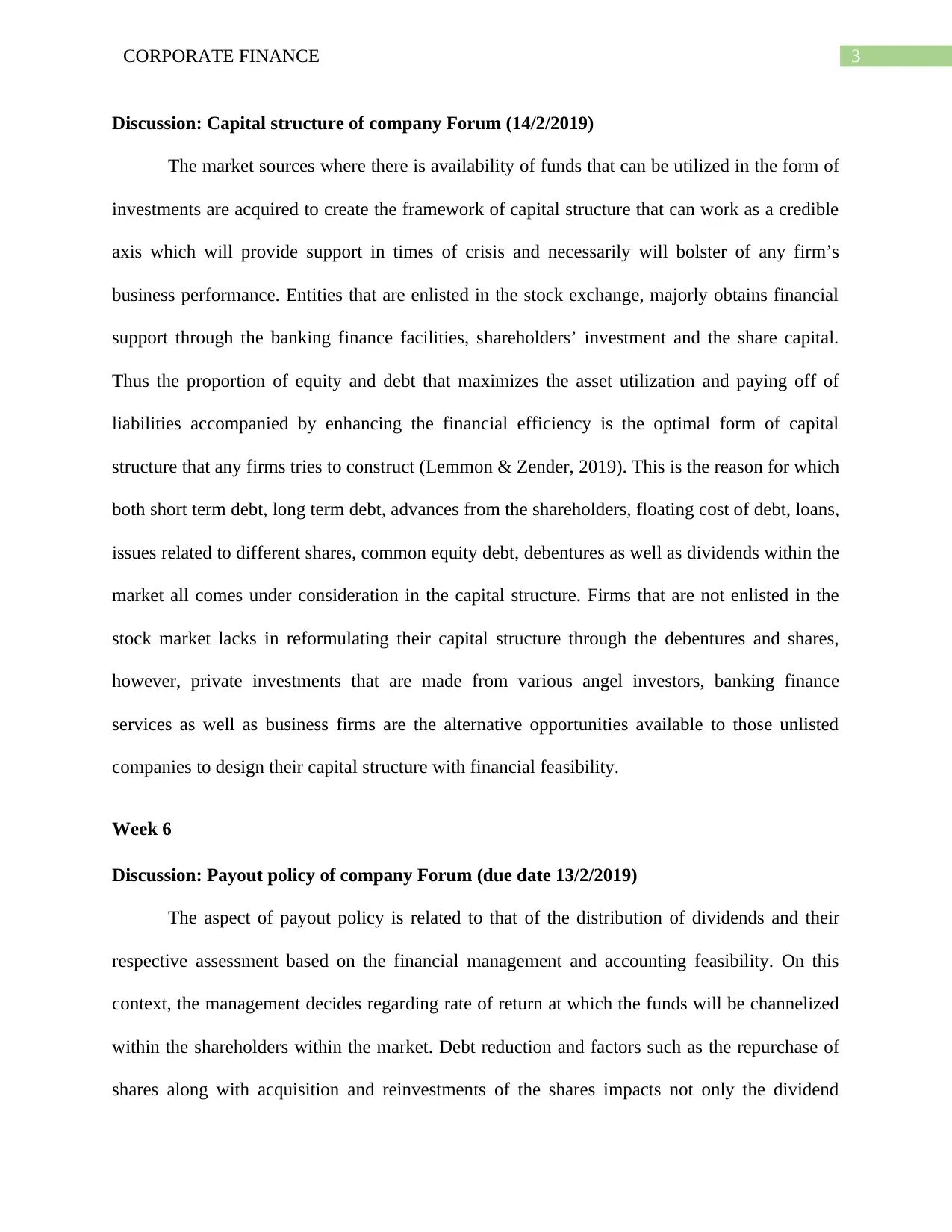
3CORPORATE FINANCE
Discussion: Capital structure of company Forum (14/2/2019)
The market sources where there is availability of funds that can be utilized in the form of
investments are acquired to create the framework of capital structure that can work as a credible
axis which will provide support in times of crisis and necessarily will bolster of any firm’s
business performance. Entities that are enlisted in the stock exchange, majorly obtains financial
support through the banking finance facilities, shareholders’ investment and the share capital.
Thus the proportion of equity and debt that maximizes the asset utilization and paying off of
liabilities accompanied by enhancing the financial efficiency is the optimal form of capital
structure that any firms tries to construct (Lemmon & Zender, 2019). This is the reason for which
both short term debt, long term debt, advances from the shareholders, floating cost of debt, loans,
issues related to different shares, common equity debt, debentures as well as dividends within the
market all comes under consideration in the capital structure. Firms that are not enlisted in the
stock market lacks in reformulating their capital structure through the debentures and shares,
however, private investments that are made from various angel investors, banking finance
services as well as business firms are the alternative opportunities available to those unlisted
companies to design their capital structure with financial feasibility.
Week 6
Discussion: Payout policy of company Forum (due date 13/2/2019)
The aspect of payout policy is related to that of the distribution of dividends and their
respective assessment based on the financial management and accounting feasibility. On this
context, the management decides regarding rate of return at which the funds will be channelized
within the shareholders within the market. Debt reduction and factors such as the repurchase of
shares along with acquisition and reinvestments of the shares impacts not only the dividend
Discussion: Capital structure of company Forum (14/2/2019)
The market sources where there is availability of funds that can be utilized in the form of
investments are acquired to create the framework of capital structure that can work as a credible
axis which will provide support in times of crisis and necessarily will bolster of any firm’s
business performance. Entities that are enlisted in the stock exchange, majorly obtains financial
support through the banking finance facilities, shareholders’ investment and the share capital.
Thus the proportion of equity and debt that maximizes the asset utilization and paying off of
liabilities accompanied by enhancing the financial efficiency is the optimal form of capital
structure that any firms tries to construct (Lemmon & Zender, 2019). This is the reason for which
both short term debt, long term debt, advances from the shareholders, floating cost of debt, loans,
issues related to different shares, common equity debt, debentures as well as dividends within the
market all comes under consideration in the capital structure. Firms that are not enlisted in the
stock market lacks in reformulating their capital structure through the debentures and shares,
however, private investments that are made from various angel investors, banking finance
services as well as business firms are the alternative opportunities available to those unlisted
companies to design their capital structure with financial feasibility.
Week 6
Discussion: Payout policy of company Forum (due date 13/2/2019)
The aspect of payout policy is related to that of the distribution of dividends and their
respective assessment based on the financial management and accounting feasibility. On this
context, the management decides regarding rate of return at which the funds will be channelized
within the shareholders within the market. Debt reduction and factors such as the repurchase of
shares along with acquisition and reinvestments of the shares impacts not only the dividend
Paraphrase This Document
Need a fresh take? Get an instant paraphrase of this document with our AI Paraphraser
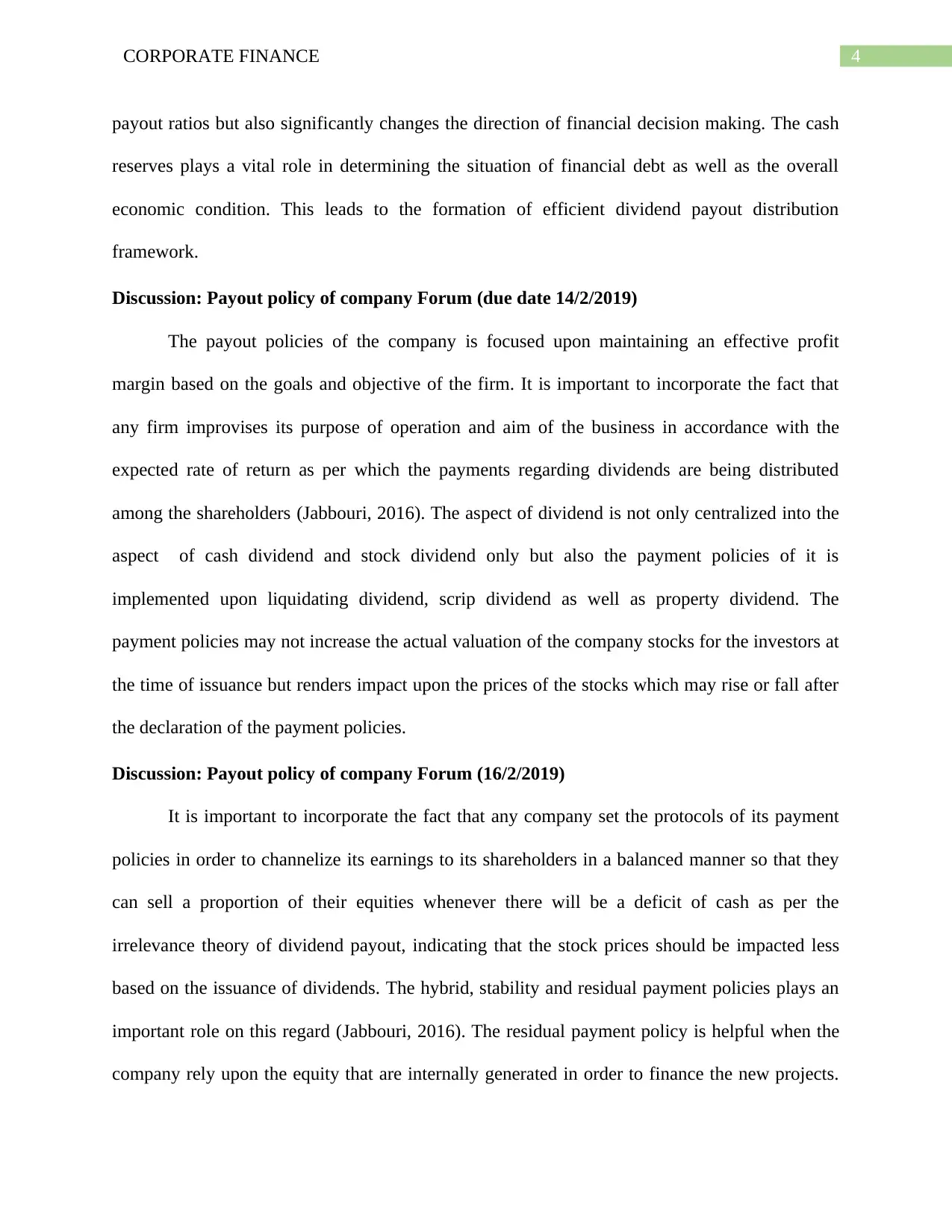
4CORPORATE FINANCE
payout ratios but also significantly changes the direction of financial decision making. The cash
reserves plays a vital role in determining the situation of financial debt as well as the overall
economic condition. This leads to the formation of efficient dividend payout distribution
framework.
Discussion: Payout policy of company Forum (due date 14/2/2019)
The payout policies of the company is focused upon maintaining an effective profit
margin based on the goals and objective of the firm. It is important to incorporate the fact that
any firm improvises its purpose of operation and aim of the business in accordance with the
expected rate of return as per which the payments regarding dividends are being distributed
among the shareholders (Jabbouri, 2016). The aspect of dividend is not only centralized into the
aspect of cash dividend and stock dividend only but also the payment policies of it is
implemented upon liquidating dividend, scrip dividend as well as property dividend. The
payment policies may not increase the actual valuation of the company stocks for the investors at
the time of issuance but renders impact upon the prices of the stocks which may rise or fall after
the declaration of the payment policies.
Discussion: Payout policy of company Forum (16/2/2019)
It is important to incorporate the fact that any company set the protocols of its payment
policies in order to channelize its earnings to its shareholders in a balanced manner so that they
can sell a proportion of their equities whenever there will be a deficit of cash as per the
irrelevance theory of dividend payout, indicating that the stock prices should be impacted less
based on the issuance of dividends. The hybrid, stability and residual payment policies plays an
important role on this regard (Jabbouri, 2016). The residual payment policy is helpful when the
company rely upon the equity that are internally generated in order to finance the new projects.
payout ratios but also significantly changes the direction of financial decision making. The cash
reserves plays a vital role in determining the situation of financial debt as well as the overall
economic condition. This leads to the formation of efficient dividend payout distribution
framework.
Discussion: Payout policy of company Forum (due date 14/2/2019)
The payout policies of the company is focused upon maintaining an effective profit
margin based on the goals and objective of the firm. It is important to incorporate the fact that
any firm improvises its purpose of operation and aim of the business in accordance with the
expected rate of return as per which the payments regarding dividends are being distributed
among the shareholders (Jabbouri, 2016). The aspect of dividend is not only centralized into the
aspect of cash dividend and stock dividend only but also the payment policies of it is
implemented upon liquidating dividend, scrip dividend as well as property dividend. The
payment policies may not increase the actual valuation of the company stocks for the investors at
the time of issuance but renders impact upon the prices of the stocks which may rise or fall after
the declaration of the payment policies.
Discussion: Payout policy of company Forum (16/2/2019)
It is important to incorporate the fact that any company set the protocols of its payment
policies in order to channelize its earnings to its shareholders in a balanced manner so that they
can sell a proportion of their equities whenever there will be a deficit of cash as per the
irrelevance theory of dividend payout, indicating that the stock prices should be impacted less
based on the issuance of dividends. The hybrid, stability and residual payment policies plays an
important role on this regard (Jabbouri, 2016). The residual payment policy is helpful when the
company rely upon the equity that are internally generated in order to finance the new projects.
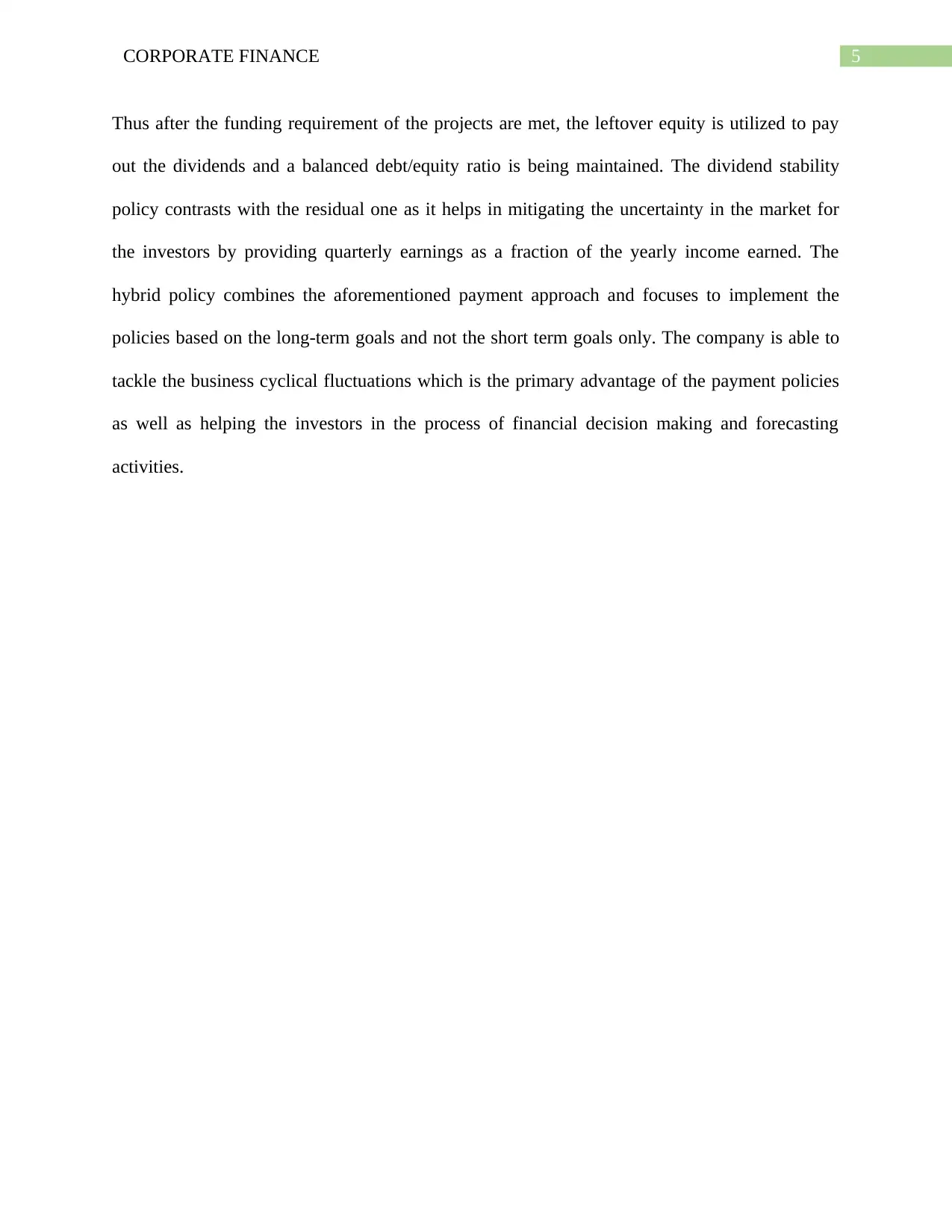
5CORPORATE FINANCE
Thus after the funding requirement of the projects are met, the leftover equity is utilized to pay
out the dividends and a balanced debt/equity ratio is being maintained. The dividend stability
policy contrasts with the residual one as it helps in mitigating the uncertainty in the market for
the investors by providing quarterly earnings as a fraction of the yearly income earned. The
hybrid policy combines the aforementioned payment approach and focuses to implement the
policies based on the long-term goals and not the short term goals only. The company is able to
tackle the business cyclical fluctuations which is the primary advantage of the payment policies
as well as helping the investors in the process of financial decision making and forecasting
activities.
Thus after the funding requirement of the projects are met, the leftover equity is utilized to pay
out the dividends and a balanced debt/equity ratio is being maintained. The dividend stability
policy contrasts with the residual one as it helps in mitigating the uncertainty in the market for
the investors by providing quarterly earnings as a fraction of the yearly income earned. The
hybrid policy combines the aforementioned payment approach and focuses to implement the
policies based on the long-term goals and not the short term goals only. The company is able to
tackle the business cyclical fluctuations which is the primary advantage of the payment policies
as well as helping the investors in the process of financial decision making and forecasting
activities.
⊘ This is a preview!⊘
Do you want full access?
Subscribe today to unlock all pages.

Trusted by 1+ million students worldwide
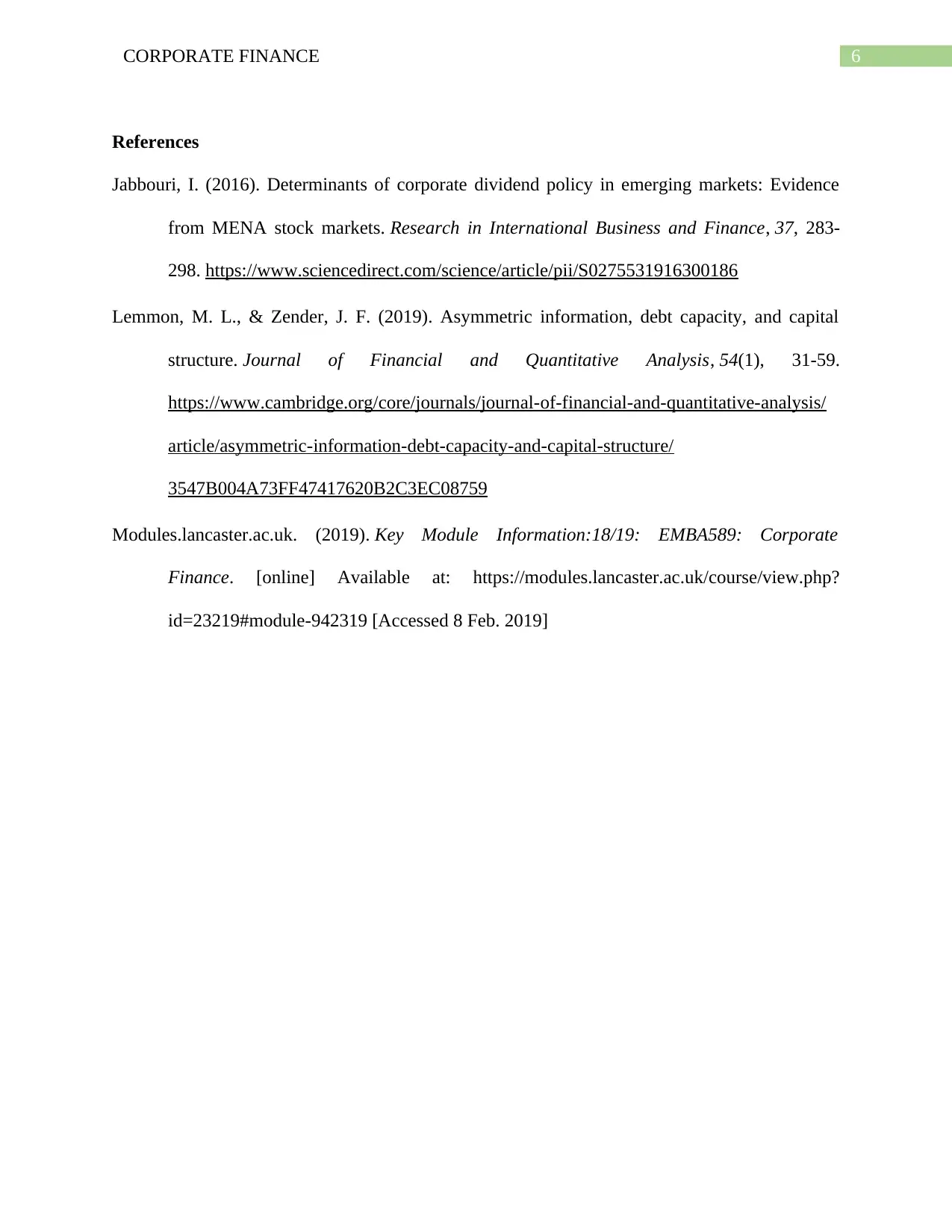
6CORPORATE FINANCE
References
Jabbouri, I. (2016). Determinants of corporate dividend policy in emerging markets: Evidence
from MENA stock markets. Research in International Business and Finance, 37, 283-
298. https://www.sciencedirect.com/science/article/pii/S0275531916300186
Lemmon, M. L., & Zender, J. F. (2019). Asymmetric information, debt capacity, and capital
structure. Journal of Financial and Quantitative Analysis, 54(1), 31-59.
https://www.cambridge.org/core/journals/journal-of-financial-and-quantitative-analysis/
article/asymmetric-information-debt-capacity-and-capital-structure/
3547B004A73FF47417620B2C3EC08759
Modules.lancaster.ac.uk. (2019). Key Module Information:18/19: EMBA589: Corporate
Finance. [online] Available at: https://modules.lancaster.ac.uk/course/view.php?
id=23219#module-942319 [Accessed 8 Feb. 2019]
References
Jabbouri, I. (2016). Determinants of corporate dividend policy in emerging markets: Evidence
from MENA stock markets. Research in International Business and Finance, 37, 283-
298. https://www.sciencedirect.com/science/article/pii/S0275531916300186
Lemmon, M. L., & Zender, J. F. (2019). Asymmetric information, debt capacity, and capital
structure. Journal of Financial and Quantitative Analysis, 54(1), 31-59.
https://www.cambridge.org/core/journals/journal-of-financial-and-quantitative-analysis/
article/asymmetric-information-debt-capacity-and-capital-structure/
3547B004A73FF47417620B2C3EC08759
Modules.lancaster.ac.uk. (2019). Key Module Information:18/19: EMBA589: Corporate
Finance. [online] Available at: https://modules.lancaster.ac.uk/course/view.php?
id=23219#module-942319 [Accessed 8 Feb. 2019]
1 out of 7
Related Documents
Your All-in-One AI-Powered Toolkit for Academic Success.
+13062052269
info@desklib.com
Available 24*7 on WhatsApp / Email
![[object Object]](/_next/static/media/star-bottom.7253800d.svg)
Unlock your academic potential
Copyright © 2020–2025 A2Z Services. All Rights Reserved. Developed and managed by ZUCOL.




